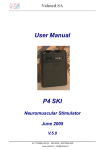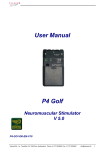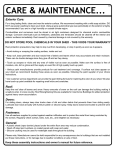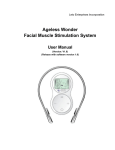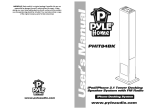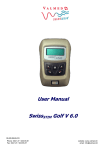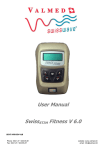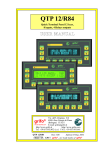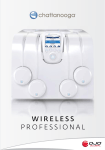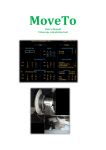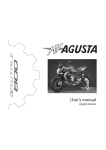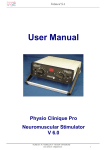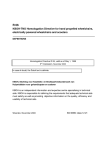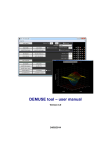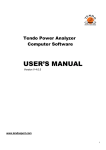Download to the P4 BIKE user manual.
Transcript
User Manual P4 BIKE Neuromuscular Stimulator P4-BI-V50-EN-V10 AV. TOURBILLON 34 - 1950 SION - SWITZERLAND www.valmed.ch - [email protected] GENERAL INFORMATION The P4 Bike is manufactured/distributed by VALMED SA, Sion, Switzerland. The P4 Bike is manufactured in accordance with the requirements of European Safety Standards EN 60601-1, EN 60601-2-10 and meets requirements of the American Standards for Transcutaneous Stimulators ANSI/AAMI NS4 – 1985. The P4 Bike is a Class II Medical Device and conforms to the requirements of European Directive CEE 93/42 and holds certificate number Œ 0535. BF device IAW IEC 601-1 “External Placement on Body” ! Read this Manual Before Using the P4 Bike Indications The P4 Bike offers optimal stimulation for : • increasing blood flow • muscle relaxation/pain relief • maintenance and strengthening of muscles • increasing resistance to fatigue (endurance) Contraindications The use of the P4 Bike is contraindicated in the following cases: • Persons with cardiac pacemakers • Persons with cancer Warnings: • • • • • • • Safety of electrostimulation during pregnancy is not established. Obtain medical advice in cases of suspected heart problems or epilepsy Do not stimulate frontal or laryngeal neck region or temporal lobes. Do not apply trans-thoracically. Keep stimulator out of the reach of children. Do not to wet the stimulator. Only electrodes supplied or purchased from Valmed should be used. Other electrodes could be dangerous for the skin or may not stimulate correctly. 2 TABLE OF CONTENTS GENERAL INFORMATION 2 INTRODUCING THE P4 BIKE 4 Functional controls 4 P4 BIKE USER’S GUIDE 5 How and when to use the P4 Bike 5 Beginning of the treatment 6 End of the treatment 6 Troubleshooting 6 Programs and schedules for use of P4 Bike 6 TECHNICAL SPECIFICATIONS 10 ELECTRODE’S PLACEMENT 11 APPENDIX: STIMULATION AND THE HUMAN BODY 15 Manufacturer disclaims any and all liability for damages caused by the improper use of this device. 3 INTRODUCING THE P4 BIKE P4 Bike Functional When you participate in any sport, it is important to be physically fit, firstly to prevent injuries and secondly to fully enjoy the sport experience without suffering afterwards. Controls 5 Congratulations and thank you for purchasing the P4 Bike. Your P4 Bike will be a true complement to your physical training, helping you to optimize your physical training and hence, enjoy your favorite sport with even more confidence. 4 3 2 The P4 Bike is specifically designed for relaxation and muscular reinforcement. The stimulation programs have been chosen to meet your needs as well, as possible Good physical training is achieved, above all, by physical exercise (running, stretching, bodybuilding, etc.). In practice it is not always possible to do this. In fact, it is sometimes difficult to combine physical training with work or health problems. It is no secret to anyone: once you stop working out, your muscles fade away very quickly. It is at these times, among others, that your P4 Bike will help maintain your muscles in condition and accelerate your preparation for physical activity, including bike. Please Note: The training suggestions provided in this manual are given for a person in good health and average physical condition. Your age, level of physical training or individual objectives must be factored into your personal use of the P4 Bike. 6 6 1 The P4 Bike unit has: • • • • 4 stimulation program indicator lights (3) A low-battery warning light (4) 2 cable output sockets (6) 2 control knobs (5). The program selection button (2) allows you to choose the treatment program. The protection cover (1) gives access to the program selection button and the battery once it is completely removed. Replace battery when the yellow warning light appears. 4 FORCE AND ENDURANCE TRAINING. P4 BIKE USER’S GUIDE HOW AND WHEN TO USE THE P4 BIKE The P4 Bike is a neuromuscular stimulator specially designed for use by cyclists. The stimulation exercise programs which are stored in the memory were developed to give you a high technology device which can be successfully used in addition to your physical training exercise program and for preparation for an outdoor sport season. As example, the annual training schedule could be as follows: − November − December Holidays 80 % force training: weightlifting 20 % endurance: bicycle − January 80 % endurance training 20 % farce: weightlifting − February 80 % endurance training 20 % force training: bicycle − March-October cycling races interspaced by force training and muscle recovery exercise program after races The muscles which principally work during cycling effort are mostly located in the lower part of your body. We estimate that the work is distributed among these muscles as follows: − quadriceps − triceps surae & hamsting − buttock (gluteus) − abdominal & paravertebral − other muscles In everyday life, when a professional schedule or other factors make it impossible for you to exercise physically and regularly, your unused muscles will undergo a gradual weakening process known as partial atrophy. In such cases, these programs can prevent atrophy by exercising your unused muscles to provide force and endurance training of these muscles. Of course, the electrostimulation is not to replace the physical exercise, which should be done as often as possible as it has important cardiovascular and other health benefits. The Program 3 is also useful to accelerate your muscle conditioning by interspacing your physical training program with electrostimulation. This is particularly useful during first few months of a year, just before the outdoor cycling season, in order to be in optimal shape for the beginning of the cycling season. Program 4: RECOVERY AND MUSCLE RELAXATION. The parameters of this program have been chosen to let you have faster muscle recovery after an intense effort. It allows the musculature to relax and the effects of this Program on stiffness or soreness after heavy exercise are excellent. 65% 16 % 13 % 4% 2% The distinctive features of the P4 Bike stimulation programs that could be used are: Program 1: MAINTENANCE OF MUSCLE POWER. This stimulation program maintains muscular trophicity. This means that it maintains and conditions muscle force and endurance. Program 2 & 3: 5 BEGINNING OF THE TREATMENT TROUBLESHOOTING (for the position of controls please refer to the picture on page 4) If your apparatus does not work for any reason and there are no blinking lights, please check the following points: 1. Make sure that the controls of intensity are in «OFF» position 2. Connect electrodes to each cable 3. Place the electrodes on the skin on the motor points of muscles to be treated 4. Connect the cables to output sockets (6) of the stimulator 5. Turn the intensity control knob (5) until you hear a switch click 1. Is the battery correctly inserted? 2. Are the cables plugs well pushed into the outputs ? 3. Are there two electrodes at the end of each channel cable ? 4. After many uses, the electrodes are not sticking well anymore ? 5. Wet their surface sparingly with water. 6. Select the program by pushing the selector switch (2) 7. Slowly, increase the intensity of stimulation by turning the intensity controls (5) clockwise until the desired level, remembering that in order to get an effective stimulation, the muscle has to contract firmly. PROGRAMS AND SCHEDULES FOR USE OF P4 BIKE *p.p.s: pulses per second Program 1 Remark: MAINTENANCE OF MUSCLE POWER. Every program may be interrupted manually, before the end of the preprogrammed period, by pushing the program selector button (2). Any of the programs may be repeated frequently as desired. END OF THE TREATMENT 1. All four treatment programs have an automatic program timer: which terminates the treatment. It does not switch the stimulator OFF and it is essential to turn OFF the stimulator after each use, by turning both intensity control knobs (5) counterclockwise past the OFF switch click, otherwise the batteries will be discharged. The audible beep can remind you to switch off. 2. Remove the electrodes from the skin 3. Disconnect the electrodes from the cables and put them back in the protective sealed bag. If a loss of electrode adhesion is noted, wet their surface sparingly with water. Type of stimulation This program consists of 3 phases as follows: 1. 10 minutes of the warm-up phase which comprises of the MUAP pattern of stimulation. MUAP pattern is a continuous train of electrical impulses with rates varying from 3 p.p.s.* to 83 p.p.s and an average rate of 10 p.p.s. This variable frequency MUAP pattern is recycled once every second. 2. 30 minutes of exercise phase which comprises of a series of 160 alternative periods of contraction and relaxation. The contractions last for 5 second each and are caused by a tetanic stimulation at a rate of 45 p.p.s. Every contraction comprises of a 3 second period during which the intensity of muscle tension increases gradually from zero to maximum («ramp») which is followed by 2 seconds of a steady contraction at a maximal level. After each contraction there is an active relaxation period lasting for 6 seconds. During the relaxation period the stimulation is subtetanic (non contracting in full) 6 at a very low rate of 4 p.p.s. 3. 5 minutes of the cool-down phase with the same MUAP stimulation pattern as during the warm-up phase. Duration The session duration is 45 minutes Application Maintenance of a muscular mass and power during period of races and / or during periods of short-lasting inactivity. Session schedule You can use the Program 1 daily if your inactivity lasts more than 5 days, in particular when either professional activities or health conditions interfere with your ability to exercise on a cycle. It is equally very useful during cycle season and can be used on alternate days with racing or intensive cycling events in order to maintain muscle trophicity and to recover after intense efforts. Instructions for use Please refer to Page 6 how to begin the treatment and how to end the treatment. Electrode placement This power maintenance Program will be done principally on the muscles of legs, that is on quadriceps, triceps suraes, hamstrings and gluteus. phase which consists of a series of 52 muscle contractions interspaced with relaxation periods. Each contraction lasts for 9 seconds and is caused by a tetanic stimulation at a rate of 83 p.p.s. Every contraction comprises of a 3 second period during which the intensity of muscle tension increases gradually from zero to maximum («ramp») which is followed by 6 seconds of a steady contraction at a maximal level. After each contraction there is an active relaxation period lasting for 21 seconds. During the relaxation period, the stimulation is subtetanic (non contracting in full) with MUAP pattern at 10 p.p.s which is recycled every second. 3. 4 minutes of the cool-down phase with MUAP stimulation pattern recycled every 2 seconds. Duration The session duration is 90 minutes Application To increase endurance of muscles and as a result to be able to undertake repeated efforts for extended time and with less fatigue. Session schedule This program can be used in addition to your training schedule, especially during a winter season. It can be used four months before start of your outdoor cycling season, at a rate of one session per week for the quadriceps muscles and two monthly sessions for gluteus, triceps surae and hamstring muscles. See electrode’s placement p.11 Instructions for use Program 2 Please refer to Page 6 how to begin the treatment and to end the treatment. MUSCLE ENDURANCE TRAINING. Electrode placement Type of stimulation The muscular endurance stimulation sessions will be done on quadriceps, triceps surae and hamstring, gluteus and abdominal muscles. This program contains 3 phases: 1. 60 minutes of the endurance workout phase which comprises of MUAP pattern (see Phase 1 of Program 1) which is recycled every 0,7 sec. See electrode’s placement p.11 2. 26 minutes of force/endurance exercise 7 Program 3 Instructions for use MUSCLE FORCE TRAINING (STRENGHTENING). Please refer to Page 6 how to begin the treatment and how to end the treatment. Type of stimulation Electrode placement This program contains 3 phases: The muscular reinforcement sessions will be done on quadriceps, triceps surae and hamstring, gluteus and abdominal muscles. 1. 25 minutes of the warm-up phase which comprises of MUAP pattern with the stimulation frequency recycled every 0,7 sec. 2. 8 minutes of intense force/endurance workout phase which consists of a series of 10 muscle contractions interspaced with relaxation periods. Each contraction lasts for 15 seconds and is caused by a tetanic stimulation at a rate of 83 p.p.s. Every contraction comprises of a 3 second period during which the intensity of muscle tension increases gradually from zero to maximum («ramp») which is followed by 12 seconds of a steady contraction at a maximal level. After each contraction there is an active relaxation period lasting for 39 seconds. During the relaxation period, the stimulation is subtetanic (non contracting in full) with MUAP pattern at 10 p.p.s, recycled every second. 3. 26 minutes of cool-clown phase with MUAP stimulation recycled each 2 sec. Duration The session duration is 60 minutes Application To increase the muscular contractile force and to result in more muscle power. Session schedule This Program is to be used in addition to your training schedule, especially during a winter season. It can be used two months before the start of your cycling season, at a rate of four sessions per month for the quadriceps and two monthly sessions for gluteus, triceps surae and hamstring as well as for abdominal muscles. See electrode’s placement p.11 Program 4 RECOVERY AND MUSCLE RELAXATION. Type of stimulation This program contains 3 phases: 1. 4 minutes of a warm-up phase which comprises of MUAP pattern stimulation recycled every second. 2. 12 minutes of an active recovery phase which consists of a series of 55 muscle contractions interspaced with periods of relaxation. Each contraction lasts for 5 seconds and is caused by tetanic stimulation at a rate of 39 p.p.s. Every contraction comprises of a 3 second period during which the intensity of muscle tension increases gradually from zero to maximum («ramp») which is followed by 2 seconds of a steady gently vibrating full contraction. After each contraction there is an active relaxation period lasting for 8 seconds. During the relaxation period, the stimulation is subtetanic (non contracting in full) with MUAP pattern at 10 p.p.s which is recycled every second 3. 4 minutes of a relaxation phase with MUAP stimulation pattern recycled every 2 seconds. Duration The session duration is 20 minutes Application To allow your muscles to relax , to increase local blood flow and reduce muscle pain due to stiffness or fatigue soreness. 8 Session schedule You can use it each time you feel the need to relax or to recover after a race or an intense effort. It can be used as well in cycling season as during winter physical training program. Instructions for use Please refer to Page 6 how to begin the treatment and how to end the treatment. Electrode placement For electrode placement please refer to page 11. 9 Size and Weight TECHNICAL SPECIFICATIONS Size: 10 x 7 x 3 cm; weight: 175 g net with battery. Channels: Two fully isolated channels with independent intensity control knob for each channel. Output: Current Waveform (during treatment): Asymmetrical biphasic with fast rise and zero net current. Warranty Two years free replacement, accessories and shipping charges. except Standard Accessories A set of four non-polar self-adhesive reusable electrodes, one alkaline 9V battery, two cables and one instruction manual. Voltage Waveform (open circuit): Low voltage, rectangular, compensated monophasic impulse. Peak Open Circuit Voltage during each Impulse: 50 Vp ±10%. Maximum Output Rating at 500 Ohm Load: RMS voltage: 5 V (volts) RMS ± 10%. Peak current intensity impulse: 90 mA (milliamperes) ±10%. during each Power Supply: One 9V alkaline or lithium battery. The output and program parameters are stable throughout the life of the battery. Controls One knob per channel for continuous intensity control. Audible click at the OFF position. Safe ON switch. Program selection button. Indicators Two green output intensity lights, four program lights, one low-battery warning light . Standard Accessories Set of four non-polar reusable self-adhesive electrodes; one 9V alkaline battery; 2 cables; one instruction manual and one storage case. 10 PLACEMENT OF ELECTRODES TIBIA The P4 Bike should only be used with the recommended electrodes. Use oval 3” by 5” electrodes for large areas (e.g., leg muscles) and round 3” electrodes for smaller areas such as forearm muscles. Do not use smaller electrodes than recommended above. Leads for Channel 1 are depicted in RED and leads for Channel 2 in BLUE. Where only one set of electrodes is shown, Channel 1 is depicted but Channel 2 may be used instead. Channels may be reversed, if desired, from that indicated in the following photos. QUADRICEPS Channel 2 electrodes may be attached to other leg in order to treat both legs On both legs CALVES On one leg 11 THIGHS TRICEPS SUREA & HAMSTING Channel 2 electrodes may be attached to other thighs in order to treat both thighs FOREARM FEMORAL BICEPS BICEPS BUTTOCK (GLUTEUS) 12 DELTOID UPPER TRAPEZIUS or TRICEPS LOWER TRAPEZIUS ABDOMINALS 13 LUMBAR VERTEBRAE or NECK-BACK 14 APPENDIX: Stimulation and the Human Body Human Muscles Almost all functions of the human body involve muscular activity. These include physical movements of the body, functions of the cardiovascular system, peristaltic movements and bladder control. Three muscles types are responsible for these activities: skeletal muscles, the cardiac muscle and smooth muscles, all of which have some characteristics in common, but differ significantly in function and performance. The P4 Bike neuromuscular stimulator interacts only with skeletal muscles. These skeletal muscles are responsible for the movements of different parts of the body. The action of these muscles is caused and controlled by nerve impulses transmitted by the brain. If muscles are not regularly exercised, their performance diminishes, a condition known as muscle atrophy. Stimulation with your P4 Bike can compensate for lack of physical activity and maintain muscle conditioning. Moreover, the P4 Bike can improve your physical condition ! It is therefore a valuable complement to physical training and should be used in combination with regular exercise. Neuromuscular stimulation improves muscle functions, just like physical exercise. It affects particularly the muscle mechanical properties such as strength, endurance, size, muscle flexibility and muscle cell metabolic functions. The results are similar to physical exercise results. This occurs since the P4 Bike emulates the brain by sending analogous electrical signals to the muscles via the motor nerves. These signals are in the form of impulses which are transmitted to the muscles through the skin by means of electrodes. To further demonstrate the capabilities of the P4 Bike , the physiological principles on which it is based as well as research results showing effectiveness of neuromuscular stimulation is discussed below . Muscle Structure and Physiology All muscles of the human body have common structure, but they are different size and function. Each muscle is made up several thousand muscle fibers attached each end to muscle tendons. a in of at When the brain sends impulses via motor nerves, muscle fibers contract, and the force of contraction is transmitted to the bones by the tendons. On a microscopic scale, some several thousand fibers in each muscle are grouped into a single motor unit. Each motor unit is connected to a single motor nerve (neuron) that stimulates the motor unit with the impulses transmitted by the brain. Such stimulation causes simultaneous, that is, synchronous contraction of all fibers in a given motor unit. The contraction of an entire muscle is the result of the summation of the contractions of individual motor units of this muscle. The contractions of several individual motor units are usually not simultaneous, thus giving the brain the ability to produce gradual contractions of the entire muscle, resulting in perfectly controlled and smooth movements. Muscle fiber cells contain myofibrils. These myofibrils shorten their length by overlapping their action and myosin protein molecules, using an electrical impulse called the action potential. This action potential is triggered by a nerve signal that reaches the neuromuscular junction point between the motor nerve and the muscle motor unit. As a result of this impulse, a neurotransmitter compound called acetylcholine is released, making the muscle fiber membrane permeable to sodium ions. The influx of sodium ions creates a local electrical current flow that initiates an action potential traveling in both directions on the 15 membrane of a muscle fiber. This action potential causes a contraction of the myofibril that travels in the muscle fiber at a velocity of approximately 5 meters per second. Therefore, when a 10 cm long muscle fiber is stimulated in the middle, the action potential will reach both ends of the fiber in approximately 1/100 second. The action potential thus excites and contracts the entire fiber in a very short time. In this example, the action potential travel time also limits the stimulation frequency to a maximum effective value of 100 impulses per second (100 Hz). The maximum effective stimulation frequency therefore depends on the conduction velocity of the action potential and the length of muscle fibers. Mechanical Properties of Muscles A relaxed, resting muscle is elastic and stretches easily. The force needed to stretch a muscle increases as the muscle is stretched. The tension developed in the muscle as a consequence of stretching does not increase linearly with elongation but increases exponentially as the muscle is stretched beyond its resting length. This is due to the internal molecular structure of myosin-action filaments in a myofibril. These filaments slide and bind to each other in rapid and non linear fashion. This rapid, exponential growth of internal muscle tension explains why muscle injuries are often caused by overstretching or overloading. When a muscle is stimulated by a single stimulus impulse while extended by a moderate load, it gradually develops internal tension and subsequently contracts. The time of this contraction (twitch) is approximately 610 milliseconds (msec) for an ocular muscle, 20-30 msec for gastrocnemius, and from 60 to 100 msec for a soleus leg muscle. Different muscles thus have different times of contraction. This is due to the fact that they perform different tasks. The ocular muscle, for example, is able to move the eyes very quickly, due to an internal myofibril structure and small size, which facilitates very rapid contractions. The gastrocnemius muscle serves a locomotion function, such as running or walking, and as such, does not need a special structure for rapid contraction. On the other hand locomotion muscles exert greater forces and are able to sustain repeated tensions (force) over longer periods of time. The postural muscle like the soleus in the leg work all the time while we are standing and as such they have a different structure which facilitates their long, non-fatiguing contractions. In general, the motor units of the muscle, and in particular their respective cells can be categorized as follows: 1. 2. 3. Slow twitch type I, very high resistance to fatigue Fast twitch type IIa, non fatiguing Fast twitch type IIb, rapidly fatiguing. All muscles in the body are a mix of these "fast" and "slow" cells and the proportion of each fiber type in a given muscle determines the properties of this entire muscle, i.e. speed of contraction and its ability to withstand fatigue. Muscle contraction force depends primarily on the size and volume of the muscle, but is also dependent on the types of muscle fibers in the muscle. Muscles with a predominance of fast fibers, type IIb, are able to exert higher forces than muscles of the same size but with a predominance of slow fibers. The predominance of fiber types is predetermined genetically, but can be also changed by exercise and/or electrostimulation. Modifying Muscle Properties Muscle properties are partially due to heritage (genetics) but are not static and can be modified through physical training or by electrical stimulation. It is a well-known medical fact that these changes in muscle properties are caused by the type of stimulation patterns transmitted by the brain to a particular muscle motor unit. By imposing on a muscle different patterns of activity either by training or stimulation (P4 Bike), one can therefore change the 16 properties of the muscle. These changes include increasing the speed of muscle contraction, increasing muscle force and endurance, increasing muscle mass and vascularization, as well as changes in muscle cell metabolism from anerobic to aerobic or vice-versa. notably the heart and the brain. In order to avoid stimulation of these organs, energy safety limits for transcutaneous stimulation of muscles and nerves have been established. In the EC, the standard (IEC-601-2-10) for unattended (home) use of stimulators is an effective current output less than 10 mA (rms) on 500 ohm load, which corresponds to a very low effective voltage of 5 V. Stimulating Muscles Muscles receive their stimulation signals from the brain via motor nerves (neurones). While it would be ideal to “tap" such neurones in order to deliver a muscle stimulation signal from an external stimulator, it is not practical as these nerves are not exposed but buried rather deeply under the skin. The most convenient, least invasive method is to transmit electrical stimulation impulses to motor nerves through the skin. This is done by using transcutaneous electrodes, placed on the skin surface. The use of transcutaneous electrodes for electrostimulation, however, includes the following trade-offs: 1. 2. 3. 4. 5. 6. Stimulation energy and the issue of cardiac safety. Correct placement of electrodes. Interface between the skin and the electrodes and skin safety. Electrical resistance of the skin and subcutaneous tissues. Voltage values and waveforms used for stimulation. Pain sensation on the skin. These tradeoffs are now discussed. In the United States, in addition to this limit, there is a limit (AAMI/ANSI NS4-85) for each stimulating impulse electrical charge, which is not to exceed 25 µC (microcoulomb = microampersecond) for transchest stimulation and 75 µC for non-transchest application. These energy safety limits were established in order to avoid the risk of cardiac rhythm disturbance. The P4 Bike design delivers the most effective stimulation with the best safety margin for the user. The P4 Bike is one of the very few stimulators on the market that uses minimal energy for stimulation. P4 Bike stimulation is effective, with as little as 1 V (rms) and 5 µC, which is 5 times below the above-stated safety margins. This is due to the unique design, which enables the P4 Bike to reduce resistances between the stimulator, motor nerves and muscles. 2. Correct Electrode Placement Physical distances between electrodes and motor nerves are obstacles (resistance) for effective stimulation. If this distance is too great, no muscle stimulation may be possible at safe energy levels. The brain stimulates muscles with very low energy levels. This is because the molecular mechanisms of nerve conduction and of muscle excitation are extremely efficient. For transcutaneous stimulation, however, much higher energy levels must be used in order to overcome the resistances that exist between the stimulator and the muscle. Muscles typically have several hundred to thousands of motor nerves entering as a bundle at the motor point. These motor points are usually close to the skin surface. Motor points are the optimal locations for external stimulation since muscle stimulation at the motor points requires several times less electrical energy than stimulation at any other location on the muscle. Hence, electrodes should be placed on the skin directly over a motor point. In the human body there are organs which can be stimulated with electric energy, The best approach is to cover the largest possible skin surface with electrodes in order 1. Stimulation Energy and the Issue of Cardiac Safety 17 to ensure that all desired motor points are covered. This is easiest to do with large electrodes. The P4 Bike electrical signal output is specially tuned to deliver effective stimulation with the largest electrodes available on the market. It is therefore possible to cover more than one motor point and effectively stimulate a group of muscles. In summary, the larger the electrode surface the more effective is the stimulation. There are very few stimulators like the P4 Bike that supply effective muscle stimulation with large electrodes. The P4 Bike requires less user skill for electrode placement and as such is simpler and easier to use. subcutaneous blood circulation before and during the stimulation session. Blood is a relatively good conductor and increased blood flow will result in better, more efficient stimulation. Increases in subcutaneous blood flow can be accomplished by a hot bath or radiant heat application before stimulation or by stimulation itself. The P4 Bike increases blood flow in the stimulated area within 5 to 15 minutes during any stimulation program. Finally, the P4 Bike impulse waveforms have a very high content of high frequencies, thus penetrating human tissue with much less difficulty than impulse waveforms of competitive stimulators. 3. The Skin-Electrode Interface 5. Voltage Values and Waveforms Skin surface-electrode contact (the Interface) is the pathway for external stimulation. This interface is an obstacle (resistance) between the stimulation signals and the muscle motor points. Resistance is normally reduced by moistening the skin with water or by using conductive gels. The P4 Bike delivers stimulation impulses with a voltage waveform that is very similar to the action potential waveform in human motor neurons. P4 Bike impulse waveforms, due to this similarity, are more easily recognized by the neuromuscular system and have lower stimulation thresholds. The P4 Bike therefore provides effective stimulation with lower impulse energy. Effective and efficient stimulation requires electrodes with minimal and uniformly distributed resistance. Your P4 Bike is designed to be compatible only with electrodes of this type. A second P4 Bike feature is automatic control of the stimulation current. This unique feature prevents excessive current density and ensures skin comfort and safety. The low internal resistance of the P4 Bike also reduces energy consumption and results in longer, more efficient operations. 4. Skin/Subcutaneous Tissue Resistance Dry skin has very high specific impedance (resistance) as does subcutaneous fat tissue. Dry skin impedance can be reduced by proper skin preparation and/or the use of conductive gels. Dry skin should be well moistened beforehand and kept moist during the stimulation session. Skin and subcutaneous tissue impedances can also be reduced by increasing 6. Pain Sensation on the Skin Our skin pain receptors are activated by external stimuli. Nerves carrying pain signals from these receptors are slightly different in diameter and conduction speed from motor neurons. Nevertheless, they can be activated by electric impulses if the stimulation threshold is exceeded. Truly effective stimulation maximizes results without undue pain. The waveforms of the P4 Bike and the low impulse energy make such stimulation possible. In contrast to many competitive stimulators, the P4 Bike stimulation session constitutes a virtually painless and rather pleasant experience. With the P4 Bike, virtually no pain receptors in the skin are activated. However, if stimulation is done at maximum intensity and for a long time, some latent muscular pain can occur due to the intense exercise. This is a healthy sign proving that the stimulation session was equivalent to vigorous physical training. 18 Stimulation as a Complement to Physical Training While regular and moderately intense exercise is undoubtedly most beneficial for the human body, it is not be always possible. As a result, during relatively short periods of inactivity - a few days or weeks, the muscles in the human body lose their force and resistance to fatigue. If a physical exercise is not intense enough or not regularly performed, the muscles lose their mass, strength and endurance. This is particularly noticeable in the largest muscles responsible for locomotion, such as the quadriceps or gluteus (buttocks), and in postural muscles such as the abdominal or paravertebral (back) muscles. Therefore, it is essential to exercise or stimulate muscles regularly to keep them in good form. The P4 Bike is the best way to retain physical condition during periods of little activity or physical training. Electrostimulation for Pain Electrostimulation allows muscle fibers to relax (relief from soreness effects), which is beneficial after physical exercise. This effect can also be antalgic (pain relief) by decreasing pain from overworked muscles. 19



















